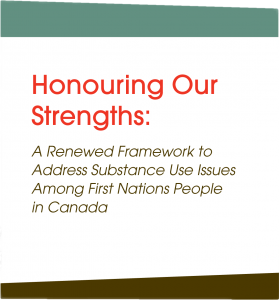[tab:Introductions]
[tab:Elements of Care]
- ELEMENT 1 – COMMUNITY DEVELOPMENT, UNIVERSAL PREVENTION, AND HEALTH PROMOTION
- ELEMENT 2 – EARLY IDENTIFICATION, BRIEF INTERVENTION AND AFTERCARE
- ELEMENT 3 – SECONDARY RISK REDUCTION
- ELEMENT 4 – ACTIVE TREATMENT
- ELEMENT 5 – SPECIALIZED TREATMENT
- ELEMENT 6 – CARE FACILITATION
[tab:Supporting the Continuum of Care]
- WORKFORCE DEVELOPMENT
- GOVERNANCE AND COORDINATION OF SYSTEMS
- ADDRESSING MENTAL HEALTH NEEDS
- PERFORMANCE MEASUREMENT AND RESEARCH
- PHARMACOLOGICAL APPROACHES
- ACCREDITATION
[tab:Conclusions]
[tab:END]
Workforce Development
>> Description
A qualified workforce plays a vital role in the quality of care clients receive. A comprehensive strategy for human resource management supports hiring and recruitment and offers practical options for professional development. It sets the stage for employee satisfaction and retention. A strategy will help ensure the right mix of staff with appropriate qualifications and training is on hand to pro- vide supports and services on an ongoing basis.
The key components of an effective approach to work- force development include:
• cultural knowledge and skills;
• recruitment;
• education and training;
• worker certification;
• worker retention;
• wages and benefits; and
• personal wellness.
>> Key Components
Cultural Knowledge and Skills
The skills and experience needed in a First Nations addictions system extend beyond clinical or counselling skills. The NNADAP and NYSAP programs were built upon the foundational belief that Indigenous-specific cultural practices drawn from an Indigenous worldview would provide the best route back to wellness. A strong basis in community and culture, and an understanding of cultural healing practices are important in both community and treatment centre settings.
Recruitment
Recruitment involves attracting, screening, and selecting qualified people for employment. The ability to attract qualified candidates is often directly linked to how a candidate views the organization and the pay and benefits provided. It is easier for organizations to recruit staff if: they have well-administered human resource policies and practices that balance recognition of western and traditional cultural qualifications; they have appropriate salaries and benefits; and the organization involves staff in decision making. Where the available pool of qualified candidates is limited (e.g., in rural and remote communities), ensuring staff have the capacity and opportunity to increase their qualifications over time through well planned recruitment and retention planning is essential.
Education and Training
Ongoing training and/or education is a requirement in the addictions field because of work complexity at the community level and the ongoing developments in the fields of prevention and treatment. With greater challenges and more diversity in services and programs, the capacity of service providers must also evolve. Specialized training, cultural competency, and multidisciplinary training are becoming more important if not necessary to help inform the workforce of emerging addiction and mental health issues. For specific or special needs groups, such as youth and women, workers often require targeted training and education to meet client needs.
Worker Certification
Certification is recognized as a key activity that enhances the skills of addiction workers. Certification involves an independent third-party assessing and acknowledging a person’s level of knowledge and skill based on a set of pre-determined standards. Some advantages to being certified include better professional recognition and job mobility, as well as higher staff satisfaction and retention.
Worker Retention
Retention is the result of having appropriate human resource measures in place. It also depends on whether an organization can create a positive and supportive work environment. Although many factors can have a direct impact on retention rates, staff satisfaction with their job, a healthy relationship with a supervisor and competitive wages are often said to be the most important factors. For supervisors, both paying recognition to staff and engaging workers in policy development/decision making may also encourage retention.
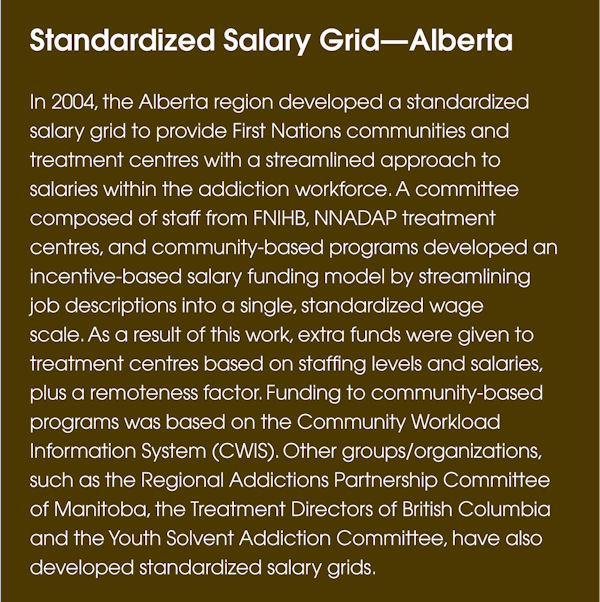
Wages and Benefits
Wages and benefits for the addictions workforce in communities and treatment centres are based on two factors: availability of funds and employer policies and practices (e.g., standardized job descriptions or salary grids). This is part of human resource management that is administered at the community level. In terms of benefits, an Employee Assistance Program can pro- vide support that will help with the stresses of providing complex services at the community level and can reduce employee burnout.
Personal Wellness
Psychological Safety
Psychological safety refers to a workplace culture that promotes healthy mental wellness. Having healthy workplace policies, a trusting atmosphere, and resources for employee assistance will encourage psychological safety and allow employees to feel comfortable. Using employee surveys and feedback, addictions organizations can enhance employees’ psychological safety.
Acknowledging and addressing vicarious trauma is one way an organization can promote and sustain the psychological safety of their staff. Vicarious trauma can be defined as a personal reaction to frequent exposure to the traumatic experiences of clients, especially when the discussions involve violence and physical abuse. Vicarious trauma generally happens over time and, if it is not addressed, can have a negative impact on the employee’s work and personal life. Due to the nature of their work, helping professionals are at an increased risk of experiencing vicarious trauma. Common signs include anger, depression, fatigue, and problems with relationships.
Self-care
Both the employee and employer are responsible for self-care. It is critical for staff to manage stress and essential to have a self-care plan. A good self-care plan considers the physical, mental, emotional and spiritual needs of a worker.
Many centres within the NNADAP/NYSAP network use yearly personal wellness plans in annual performance appraisals to ensure that self-care is part of the workplace. Workshops, training events and professional development opportunities can promote self-care for staff.
>> Current Status
The NNADAP/NYSAP workforce includes approximately 1,500 treatment centre and community workers. While they bring passion and dedication to their work, they can also be overlooked and not appreciated for the role they play in the system.
Community addiction workers are employed through their community. Their salary is generally set by fund- ing authorities and available resources. Communities hire workers and set salaries using a variety of means, (e.g., wage scales and job descriptions). In most regional needs assessments, salaries were found to be one of the most important barriers to hiring and retention. Limited resources and policy issues often make it hard for communities to set aside resources each year for salaries.
The on-reserve addictions workforce ranges from workers with formal education (like post-graduate degrees) to some staff with more limited addictions training and others still with cultural knowledge, skills and community sanctioning to conduct ceremonies with relevance to addictions treatment and prevention. All workers face the challenge of keeping up with emerging and complex addiction issues. During the last decade, both the addictions workforce and employers have acknowledged the importance of training and certification as a key way to meet standards and to provide effective, high-quality, culturally relevant addictions treatment and prevention services.
Training is a key requirement for workers to maintain certification. Unfortunately, prevention or treatment training does not occur in a systematic manner and is not consistent across all regions. Access to career development can be limited or lacking in smaller communities.
Despite differences across regions, most of the work- force at the community and treatment centre level has addictions training, certification training, a degree, or diploma. Treatment centre staff access to clinical supervision and support is also increasing.
In general, hiring and retention are common problems in addiction programs. Isolation and lack of community supports are also issues of concern. High staff turnover remains a significant problem, with skilled and experienced workers moving to the provincial system or leaving this work altogether. The reasons range from inadequate salaries and high workloads, to stressful working conditions and a lack of cultural supports.
>> Renewal Opportunities
• A national addictions workforce strategy that respects local governance could provide guidance and support to employers for all aspects of human resources related to the addictions workforce.
• Competency-based job descriptions and training may help to support both worker development and better services for clients. Generic job descriptions can be a useful tool for multiple employers.• The huge demands on addiction workers make it critical that a healthy work environment exists. A process for collecting and sharing strategies that promote worker wellness may provide additional support to both community and treatment centre staff. This process may include strategies for:
º developing wellness plans for staff;
º identifying opportunities for workers to voice their opinions on decisions;
º developing and reviewing healthy workforce policies;
º providing regular events/awards to recognize workers;
º ensuring employees have formal ways to provide and receive feedback; and
º creating plans for employee development.
• Enhanced networking among workers as a means for regional information exchange and networking forums to:
º share effective approaches;
º enhance service coordination; and
º encourage formal and informal supportive professional networks.
Cultural Knowledge
• Identification of ways to link cultural knowledge, skills, and community-based cultural practices. This will be important for raising cultural competency within mental health and addiction services.
• Recognition of cultural knowledge and skills in qualifications for mental health and addictions services.
• Compensation of cultural knowledge and skills in setting salaries/wages.
• Provision of, or allowance for, cultural knowledge and skill development through culturally based professional development and psychological safety strategies.
Recruitment and Retention
• A key to longer term recruitment could be greater advancement opportunities through:
º laddered approach to career building, which may lead to degrees or post-secondary education;
º distance education programs;
º support for education through bursaries or scholarships;
º supervised clinical training;
º activities to promote a psychologically safe workplace;
º culturally appropriate professional support through an Employee Assistance Program, which includes access to Elders and cultural practitioners; and
º orientation programming for new staff that is critical in supporting the engagement of new employees.
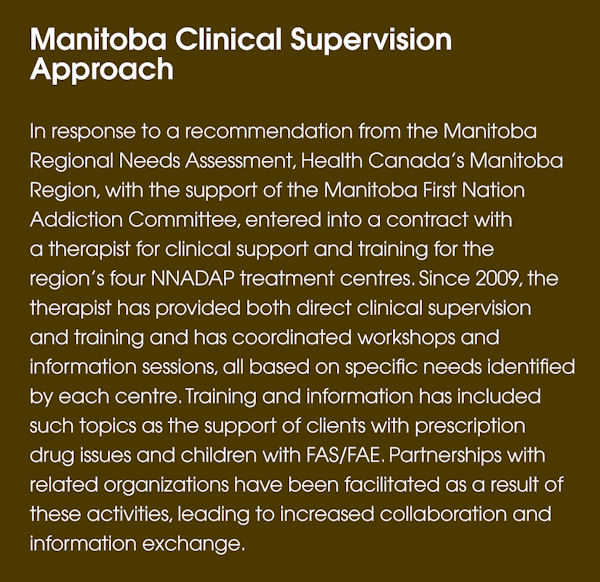
Education and Training
• An ongoing focus on education and training of workers, especially with respect to emerging issues (e.g., prescription drug abuse), target populations (e.g., women, youth, and people with co-occurring mental health issues), and essential skills and competencies (e.g., evidence-based prevention and health promotion strategies). This training can be supported through an approach to clinical supervision, either at community or regional levels, and may be enhanced through a mix of video-conferencing and distance education along with training and flexible work options.
• Emphasis on addiction and mental health training for a range of other care providers who may also be involved in client care. This may include family and community members, other community service providers, primary care and other medical staff (e.g., nutritionists and dental teams), and off-reserve service providers. This training could focus on signs of sub- stance use or mental health issues; available services and supports; community and cultural considerations; and specific considerations for their area of practice.
• Partnerships between communities and cultural knowledge societies/Elders, regional training bodies, schools, universities, and provincial, territorial, or federal government agencies would help to ensure that supports are in place for workers seeking education. As well, training programs available within education institutions are required to pro- vide courses and education necessary to complement workforce competencies.
• Partnerships with certifying bodies and schools/universities to ensure training and certification standards are accessible and culturally-relevant for the First Nations addictions workforce.
Certification
• Respond to the need and demand for culturally responsive certification standards for NNADAP and NYSAP workers.
Wages and Benefits
• More information and analysis are needed before regional and community salary scales and job descriptions endorsed by First Nations leadership can be applied to the addictions work- force. These scales could reflect both clinical and cultural competencies, and may draw upon certification data as key criteria within scale development.
Governance and Coordination of Systems
>> Description
Strong governance and coordination among and within systems are vital to developing and maintaining a continuum of care in a First Nations community.
The responsibility for the governance of on-reserve addiction prevention and treatment services often rests with First Nations chiefs and councils, treatment centre boards of directors, tribal councils, and First Nations self-government structures. Specific to mental health and addictions, governing groups are responsible for two main functions: 1) making sure that needs are being met through systems design and policy; and 2) supporting accountability in all aspects of service delivery.
Key components that support both the governance and coordination of systems include:
• Community-driven addiction services;
• Inter-jurisdictional relationships and collaboration; and
• System level partnerships and linkages.
>> Key Components
Community-driven Addiction Services
A stable and progressive addictions service must be driven by First Nations communities and embody their cultures, values and traditions.
Inter-Jurisdictional Relationships and Collaboration
An effective addictions system requires the development/ maintenance of inter-departmental and inter- jurisdictional relationships and collaboration. This kind of collaboration helps to understand:
• The impact of social determinants of health and their role in service delivery and continuity of care for clients (e.g., mental health, corrections, child welfare);
• Coordination and transition between services and supports (e.g., between provincial detox and community-based services); and
• How services can be responsive to the unique needs of First Nations people and communities (cultural competency).
It is important that the link between accountability and communication be clearly defined and actively sup- ported. Collaboration requires a clear understanding of the roles and responsibilities of on-reserve governing bodies and service providers, as well as those of regional, provincial, and national service providers.
System-Level Partnerships and Linkages
Key opportunities for collaboration exist among governance bodies, health providers, and social service providers. In some cases, this collaboration is facilitated through community health boards or advisory committees that coordinate health services including NNADAP/NYSAP services or a regional NNADAP organization that represents all First Nations communities.
Establishing stronger links among addiction networks, community-based representatives, community-based programs and other key partners at the community level (e.g., research, political policy, and advocacy organizations) provides an opportunity to promote the interests of First Nations at regional and national levels. Regional and national networks can provide opportunities for knowledge development and exchange; a forum for contributing to the evolving addictions field; and ongoing advocacy for programming. All of these are vital in supporting community-based addictions systems.
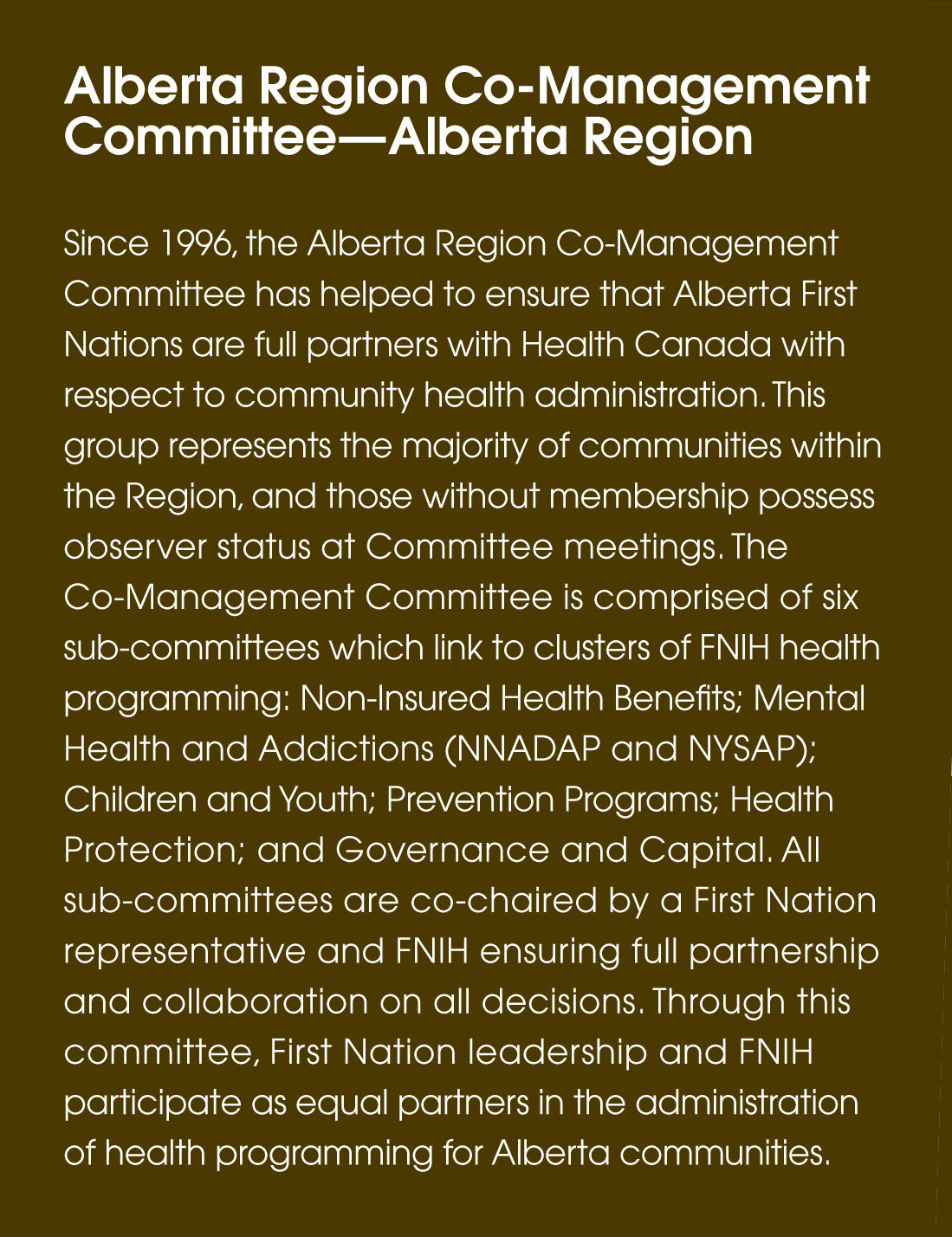
>> Current Status
Diversity exists in governance structures for First Nations people, at all levels. Depending on the community, these may include: band councils, self-government, regional tribal councils, and provincial/territorial organizations, as well as national Aboriginal organizations representing women, urban Aboriginals, addiction, and mental health. These issues can present unique challenges when adapting governance and service needs for such a diverse client base.
Community decision makers and leadership have significant roles in reducing substance use issues within a community. Without clearly defining governance structures, the roles can be unclear between a First Nations community governance body and the addictions or mental health service, especially with respect to who is responsible for setting policies and standards.
The level of integration and collaboration between community addictions services and off-reserve or provincial services varies widely. In some regions, collaboration is formal and well-established, while others have little or no collaboration. This is the case for detoxification services in particular.
Several regions currently have forums where regional working groups or committees may network, identify needs and challenges, and advise on regional and/or provincial actions. As well, the National Native Addictions Partnership Foundation serves as a national advocate in advancing First Nations and Inuit culturally based addictions services.
NNADAP/NYSAP currently partner at the national level with the:
• Assembly of First Nations;
• Inuit Tapiriit Kanatami;
• National Native Addictions Partnership Foundation;
• First Nations and Inuit Mental Wellness Advisory Committee; and
• National Native Mental Health Association.
Some NNADAP representatives are part of mainstream addictions systems through the work of the National Framework for Action governed by the Canadian Centre on Substance Abuse and other partners (e.g., National Treatment Strategy Leadership Team, National Advisory Group for Workforce Development, and the National Treatment Indicators Working Group). There are, however, wide differences in the organization of, and support for, regional networks and mobilization. The way that each network informs national and federal policy and systems also varies.

>> Renewal Opportunities
• Recognition, respect, and support for the idea that healing is connected to self-determination.
• Recognition of the major role that all aspects of governance, system coordination, and service delivery play in each client’s or family’s experience with accessing and using services, and ultimately, in positive client outcomes.
• Recognition of the important roles local control and cultural continuity play in community health and well-being. This may include:
º indicators of how self-government is being achieved;
º use of the courts to obtain First Nations title to lands;
º degree of local control over health, education, and police services;
º community facilities aimed at preserving culture;
º local control over child welfare;
º community capacity across determinants of health; and
º women’s involvement in governance.
• Recognition of Indigenous society, and support for communities (where desired) by promoting traditionally-based governance structures, customary land ownership, and internal reconciliation and healing. These are seen as vital to social cohesion based on the linked obligations and responsibilities that form the basis for Indigenous societies.
• Governance training for health boards and treatment centres. Such training would focus on good governance practices, workplan development and ways to enhance collaborative relationships among key partners (internally, as well as those that are inter- departmental, inter-jurisdictional, and system wide.)
• Networks for support, advocacy, knowledge development, and information exchange. These net- works could also function within system-supports to ensure that changes to policies and laws truly reflect the needs of NNADAP/NYSAP addictions and mental health services and support issues around changing community needs.
• Active monitoring of changes to laws that have an impact on the addictions field (such as taxation, laws on illegal drugs, privacy laws, labour standards, Youth Criminal Justice Act, and Child Welfare).
• Clear and consistent communication should guide and then inform policy and service delivery, which may include measures to increase communication capacity both within and across communities.
• Promoting First Nations leadership involvement in reducing substance use issues by:
º being role models for healthy living;
º offering political/governance support to ensure competent staff with fair compensation in service delivery;
º respecting and safeguarding treaty and Aboriginal rights, helping to set up links to multi-level services to ensure gaps are filled;
º supporting the need for cultural competency in services both within and outside of First Nations communities and organizations; and
º setting up methods to manage grievances and service complaints.
Addressing Mental Health Needs
>> Description
It is generally understood that substance use and mental health issues are strongly linked and often occur together. For instance, mental health issues can lead to the use of substances as the person tries to cope with, or numb, dis- tress. As well, substance use can lead to mental health issues, such as depression and anxiety.
The terms concurrent disorders or co-occurring disorders refer to a combination of a mental health disorder and a substance use disorder. Common mental health issues include mood, anxiety, and personality disorders, and post- traumatic stress. People with co-occurring issues tend to have poor general health (known as co-morbidity).
To prevent substance use issues, it is vital to take a holistic approach to mental wellness with a focus on strengths, resiliency and recovery. There are many system approaches to ensure that the mental health needs of clients with substance use issues can be addressed. Some are through referrals, cooperation, and collaboration among addiction and mental health services both on- and off- reserve; others involve using specialized mental health supports that are part of existing addiction services; and some comprehensive services exist to more fully address all of a client’s and community’s mental wellness needs.
An awareness of the frequent co-occurrence of mental health and addiction issues has significant implications for both addiction treatment and prevention. In many cases, it is best to address issues at the same time, through integrated or collaborative approaches.
Key components of an effective approach to addressing mental health needs within an addictions system include:
• strong referral and case management networks;
• centres able to deal with concurrent disorders;
• supports for community-based mental wellness;
• Indigenous approaches to mental health; and
• medical assessment and medication support when necessary.
>> Key Components
Strong Referral and Case Management Networks
For clients who require both mental health and addiction services, these services may not always be provided “under one roof.” However, services and supports could also be made available through strong connections among services from various elements of care. For example:
• community-based mental health and addictions aftercare could follow intensive treatment at a provincial mental health facility or acute care services in a community;
• ongoing community-based mental health counselling, including family counselling, could follow NNADAP/NYSAP treatment;
• connections with primary care services could be made within and outside the community with respect to supporting and managing mental health issues; and
• a visiting Elder/psychologist and a NNADAP prevention worker could work along with a client and their family in a community.
In all of these examples, it is important to have mechanisms in place to support collaboration. Some of the mechanisms include culturally specific assessments, standardized assessments, well-defined protocols for case management, and a shared understanding of the relationship between the mental health and addiction issues for that client. As well, a shared understanding of the importance of culture and community as supports to well-being can help service providers work together to meet a client’s needs. This can broaden the network of supports available for that client.
Centres able to Deal with Concurrent Disorders
Existing addiction services can safely and effectively meet the needs of some clients with concurrent disorders, particularly those that are less severe. This may be the case if the addiction service has well-trained staff with access to clinical supervision and specialized cultural supports to provide support to individual client cases. Access to med- ical supports outside the centre is needed for cases using drug-based approaches to help a client manage a mental health condition. However, it may not be necessary or feasible for all centres to have the capacity to manage specialized concurrent disorders. What is more practical is for every centre to have some level of competency with respect to mental health issues, and to have specific centres within the regional and national continuum of services that can provide specialized concurrent disorder treatment, based on need.
Supports for Community-based Mental Wellness
Strong community-level supports designed to be flexible and to meet the mental wellness goals of a community can eliminate the need for more acute services for some clients. For instance, when it comes to diagnosis, research suggests that for youth, early diagnosis and intervention for a mental health issue can reduce its severity and thus reduce the chance that the client will develop a substance use issue later in life.
Community-level supports can also provide assistance to other clients before they access specialized services and/ or help them with their well-being when they return home. The latter may involve in-community supports, (e.g., multi-disciplinary teams to help provide aftercare for families). For many people, stigma is often a major barrier to accessing services which reflects the need for trustful relationships. Mental health supports help to encourage community members to access counselling or specialized services.
Networks and links to provincial services are essential, especially for clients with concurrent disorders and other acute mental health issues. Access to community-based, culturally appropriate supports for mental wellness are just as important. This includes prevention, health pro- motion, early identification, intervention, and follow-up activities and supports that are connected to, and coordinated with community development efforts.
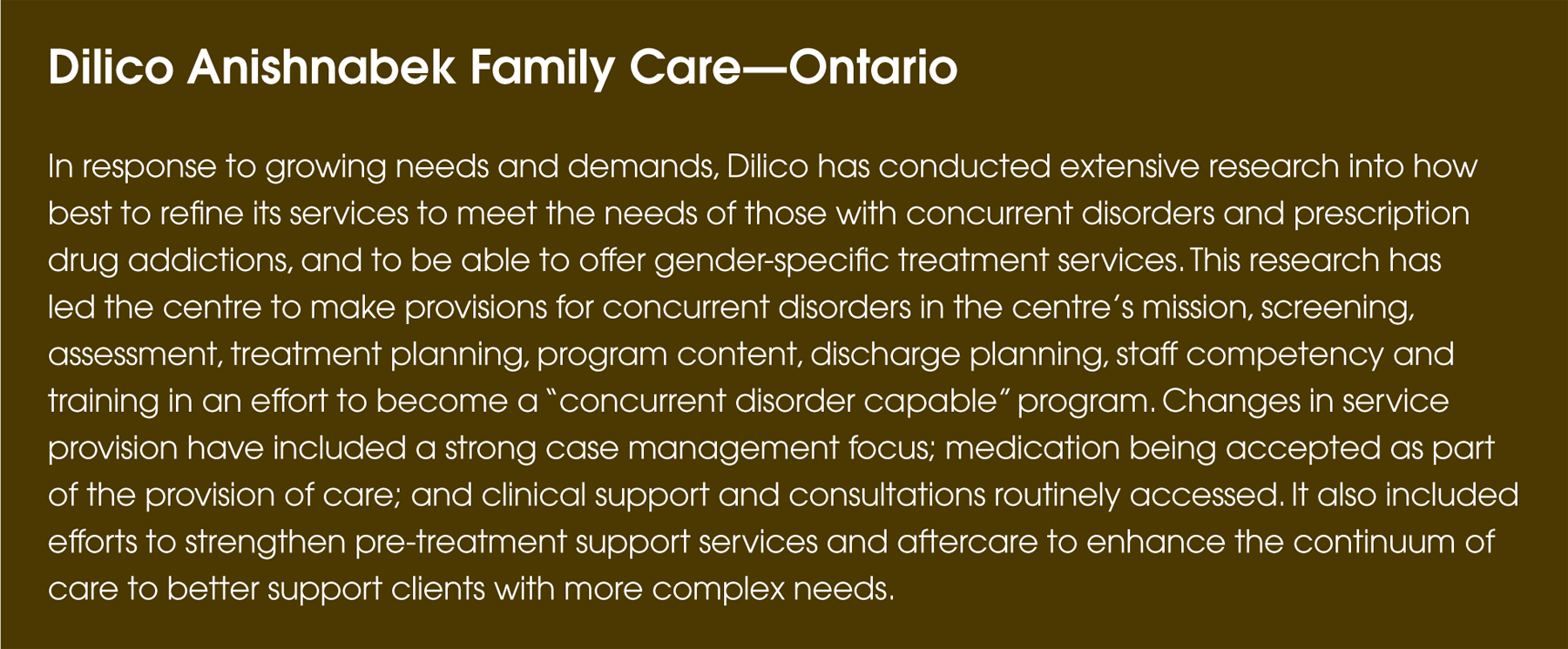
Indigenous Approaches to Mental Health
Providing cultural or Indigenous approaches along with mainstream clinical approaches is often necessary to reflect the diversity of client needs. The specific cultural approaches used and the right balance between the two must be determined by clients, families, or communities themselves. Consideration of these approaches must also respect diversity within the First Nations community and adapt to varied approaches to care. For instance, some cultural practitioners are trained in ceremonial practices for assessment and diagnoses, and in the use of natural medicines, which can be an important way to improve the well-being of those dealing with both addictions and mental health issues. Based on a client’s preferences, their strengths, and their needs, the role of Indigenous medicines and ceremonies should be seen as part of, not separate from, other aspects of support and care.

Medical Assessment and Medication Support
For many clients a medical assessment is required to rule out physical illness that may cause or play a role in mental health symptoms, and to identify mental health issues. Key factors in knowing whether a mental health diagnosis is needed relate to the severity of a client’s symptoms; the distress the symptoms cause; and the degree to which they affect how the person functions in the world. This can include being able to make and maintain relationships and friendships; to work in some way; and to take care of oneself and/or others. Based on a medical assessment, medication may be prescribed to manage symptoms of mental illness and improve client safety.
In addition to doctors, nurse practitioners can also play an important role in the administering and prescribing of medication. In some regions, they can renew prescription medications used to treat mental health issues (e.g., depression, anxiety disorders and schizophrenia), while in other regions they can both prescribe and renew medications. This can affect whether clients with mental health needs can get new prescriptions on-reserve. However, an ongoing concern for many communities, particularly those that are rural and remote, remains access to medical assessments, prescribed medication, and complementary psychological, social, and cultural support.
>> Current Status
Mental health and addictions have historically been viewed and treated as separate conditions with separate systems of care. Sometimes integrating mental health and addiction systems has raised the concern that by trying to address mental health issues within addictions program- ming, the focus and expertise on addictions will be lost. Although structural issues related to systems integration may be complex, the need for stronger collaboration between mental health and addictions services is essential in addressing the needs of clients. This is consistent with client and community requests for more effective, holistic, and client-centred services.
The high co-occurrence of mental health and addiction issues requires strong collaboration between and within services, screening, referral, assessment, and treatment methods. Collaboration between addictions and mental health services is taking place in some First Nations communities. However, the supports needed for integrated treatment plans often do not exist. Some of those sup- ports include culturally specific assessments, standardized assessments, protocols in place for case management and information sharing, and the correct screening tests for mental health conditions.
Currently there are limited specialized mental health services available. Mental health services are limited and fragmented and often delivered by multiple sectors. These gaps in available mental health services can be found both on- and off-reserve. While an established system of on-reserve addiction services exists across the country, on-reserve mental health services are underdeveloped with little or no coordination existing between the two systems. In addition, access to provincial mental health services is limited due to long waiting lists. These services may not be culturally appropriate or safe, and may not exist at all for certain populations, such as youth.
A challenge within the system occurs when clients are not only unable to access more specialized services, but where there are no specialized mental health services, or when long waiting lists prevent access to treatment, the local supports available to clients are inadequate to meet their needs.
The number of addiction treatment centres that can address concurrent disorders is increasing. In all cases, this has involved staff receiving specialized training, clinical supervision, and access to other psycho-medical sup- ports. Where there is limited access to these supports or difficulty in recruiting and retaining qualified staff, the capacity to work with more complex cases will remain a challenge. The same is true at the community level, where community-based prevention workers need more support and training to meet the needs of clients with concurrent disorders.
An emerging area that many centres and community workers have had to deal with is the use of mental health medication. There is a significant body of research supporting the idea that people with concurrent disorders have significantly better outcomes when they are appropriately medicated while receiving addiction interventions at the same time, and that medication or counselling alone is less effective. Determining the appropriateness of medication often requires monitoring by a qualified medical professional.
Currently, some NNADAP centres have policies restricting mental health medication; however, many others have adapted their services to accommodate clients taking mental health medication. These centres have reported that the accreditation process has been particularly helpful in providing guidance on protocols and policies for medication management.
There are examples of community mental wellness supports, funded through programs such as Brighter Futures or Building Healthy Communities; however, they are generally described as insufficient to fully address a community’s needs or are not carried out in a systematic or deliberate fashion (see Element 1 for more information on community wellness approaches).
Multi-disciplinary, community-based mental wellness teams provide a variety of culturally safe mental health and addictions services and supports to First Nations communities, including mobile clinical services; access to specialized mental health services; community development; and traditional/cultural programs. The mental wellness team concept supports an integrated approach to service delivery (multi-jurisdictional, multi-sectoral) to build a network of mental wellness services for Aboriginal people living on and off reserve. Mental wellness teams are owned, defined and driven by the community and include traditional, cultural, and mainstream clinical approaches to mental wellness services, spanning the continuum of care.
>> Renewal Opportunities
• Incorporating cultural or Indigenous approaches along with mainstream clinical approaches into mental health and addictions services is important to reflect the diversity of client needs.
• Mental health and addictions workers must be culturally competent and have cross-disciplinary train- ing and access to networking. In particular, workers could be trained in basic counselling skills, case management, family counselling and basic knowledge of addiction and mental health issues.
• A long-term approach to community-based coordination of mental wellness services, supports, and workers. This may involve:
º development of community-based wellness plans, inclusive of mental health, addictions, and community development;
º implementation of multi-disciplinary teams, adapted to community needs and inclusive of both mainstream and cultural practitioners, within and across communities; and
º identification of a wellness coordinator within each community tasked with providing leader- ship on all mental health, addiction, and community development activities. Such a worker would require a range of skills and competencies and may also provide direct service delivery.
• Stronger screening and assessment to help addictions workers better identify client needs, and then find the “best fit” with available services. A key avenue for this may include standardized assessment tools or approaches, along with relevant training.
• Flexible funding options at a community level to support stronger mental health supports (both Indigenous and clinical), will help to meet the needs of clients with concurrent disorders, as well as their family’s needs.
• A systematic approach is needed to support NNADAP and NYSAP treatment programs to become more capable in addressing the needs of clients with concurrent disorders. This will ensure a dual focus on mental health and addiction issues throughout the treatment process, in policies and procedures (e.g., for medication and psychiatric emergencies), as well as in screening, assessment and referral; intake procedures; and treatment sequencing and analysis.
• Access to appropriate services needs to be sup- ported by referral networks that allow addiction workers and other community workers to easily refer clients to more specialized resources, such as physician services and acute mental health services. As well, having ongoing links to community resources will help workers better support clients when they return home.
• Specialized treatment services for youth who would benefit from more development and new approaches to care.
• Medical transportation policies that allow for access to the right kind of care based on the needs of the client and support a return to treatment, even where there has been a recent attempt at treatment.
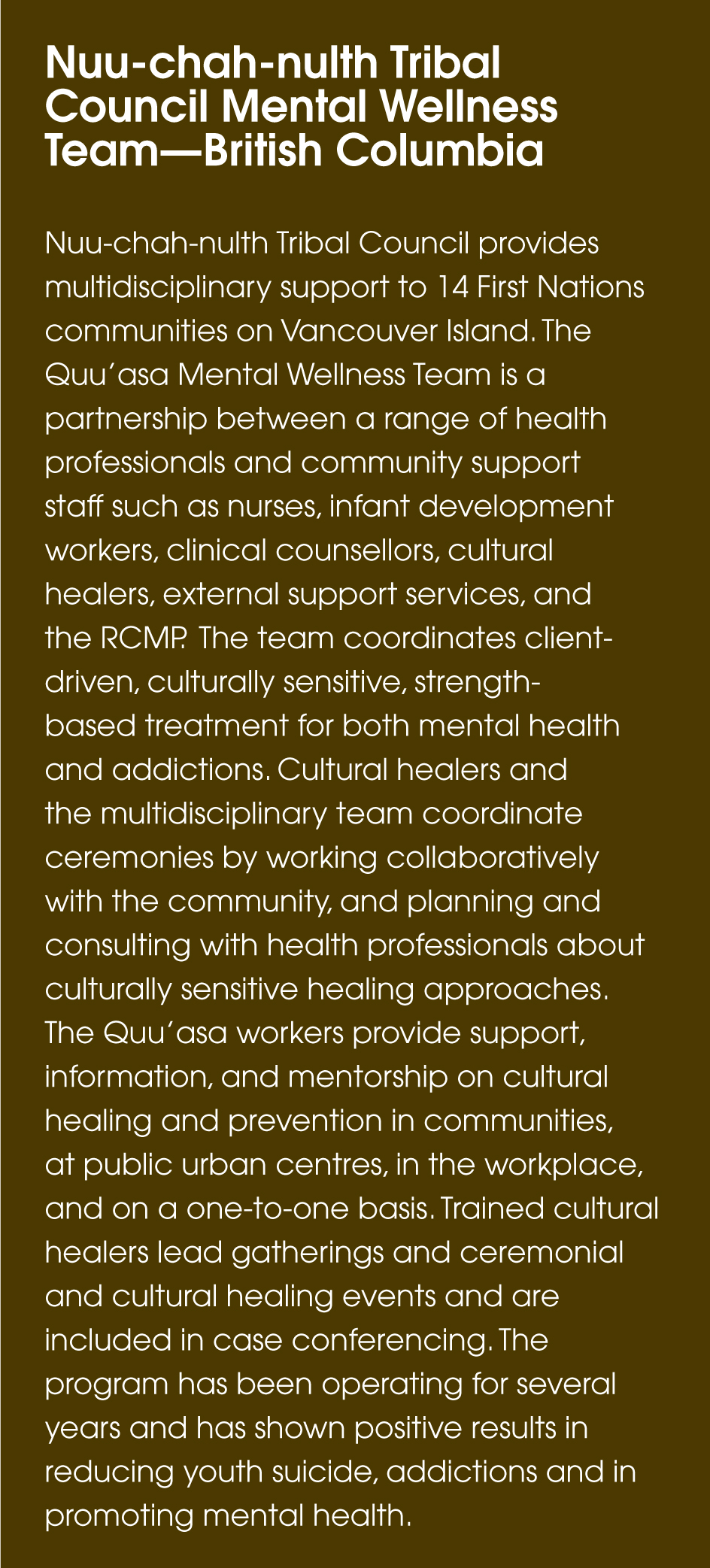
Performance Measurement and Research
>> Description
Performance measurement and research are both relevant to the development and delivery of effective programs and services. They make it possible to develop approaches that best meet the needs of clients while getting the most value from available resources. Performance measurement is an important way to demonstrate to clients, communities, and stakeholders that the work being done in addictions programs is having a positive impact on the well-being of First Nations communities. Coordinated research activities are vital to building a stronger evidence base and understanding why what is being done works within particular con- texts, from a First Nations perspective. It can also make a case for changes that may need to be introduced.
Key components of a strengthened approach to performance measurement and research in a First Nations addictions system are:
• population health information;
• integrated performance measurement system;
• research strategy; and
• knowledge exchange.
>> Key Components
Population Health Information
Population health information includes both health status (outcome measures) and indicators of the need for health care (socio-economic measures). Socio-economic measures include determinants of health data which can be used to conduct needs-based planning and inform future programming that focuses on improving overall health.
Integrated Performance Measurement System
Integrated performance measurements can be an effective way to determine where change may be needed within an organization. Key elements of an integrated performance measurement system include tracking and reporting of activity data (e.g., service availability and rates of use, results data, and client outcomes). This is generally done by using a systematic approach to record keeping, such as a case management or an electronic system. It is also important to observe this data alongside defined human resource indicators, such as staff turnover, staff grievances, staff attendance and staff satisfaction to link the impact on client care and service outcomes.
Research Strategy
A well-defined research plan identifies and funds research in areas most important for client and community wellness. Specific research is necessary for demonstrating the impact of cultural interventions. It is important that both the research plan and any research projects recognize cultural knowledge and the values of a community with respect to the principles of community-controlled and community-owned research.
Research may also support the development of new treatment approaches, or measures to improve care for the community (e.g., for certain kinds of addictions, or clients with specialized needs); or may include research on other variables that have an impact on access to and impact of care received. Meaningful program reviews usually address both performance measurement and research plans.
Knowledge Exchange
Knowledge exchange helps with the transfer and integration of research findings and information among the areas of research, policy, and practice at a community, regional, and national levels. Knowledge exchange sup- ports the development of new approaches to care and helps to refine services at all of these levels through methods including face-to-face meetings, conferences and web-based forums.
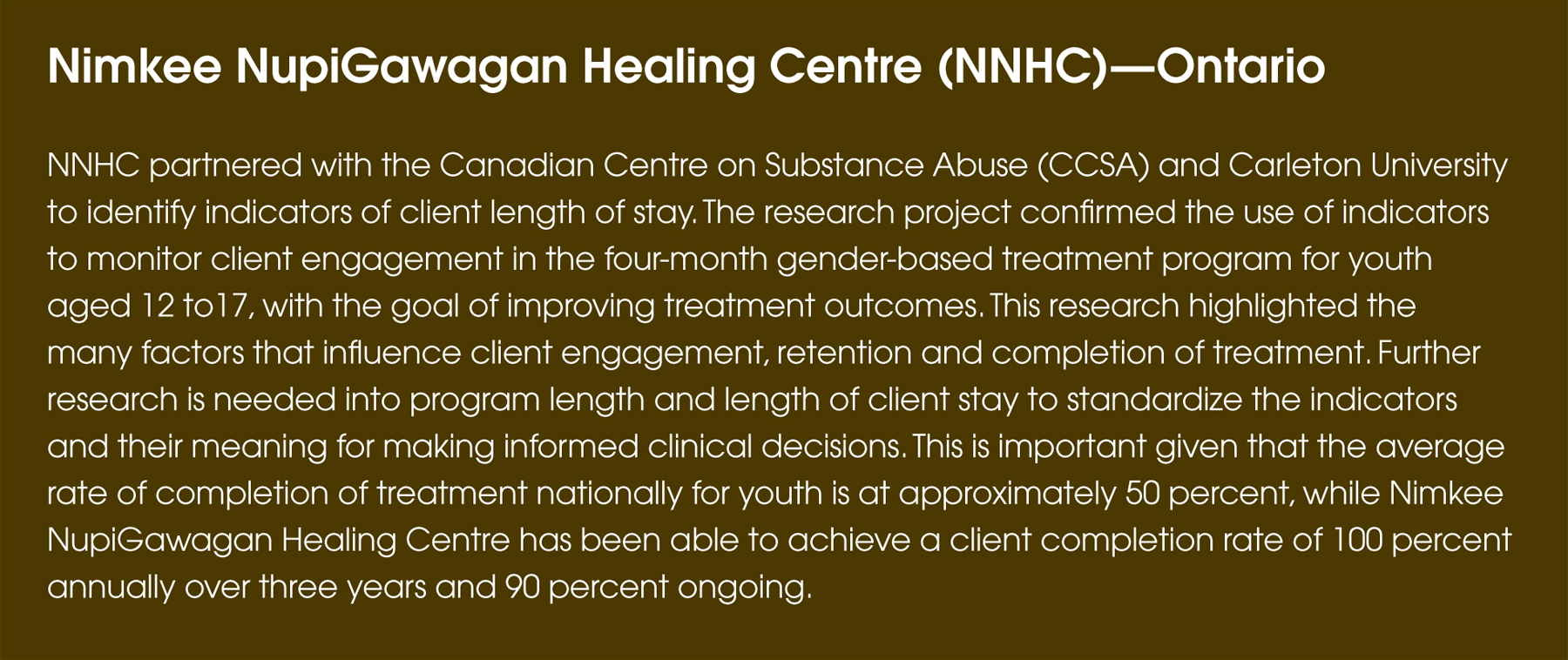
>> Current Status
Population-level data specific to First Nations in support of monitoring or addictions-related program planning is limited. Canadian population-level research on substance use often does not include on-reserve populations and often does not use large enough samples to identify First Nations living off-reserve.
Concerns identified during previous efforts to obtain population-level data on substance use among First Nations have included low levels of participation; lack of cultural sensitivity in the survey tools and interpretation of results; and culturally biased diagnostic tools. There are also sensitivities around the use of this type of data, especially about how to reflect a holistic under- standing of wellness. The most credible source of population-level data available is through the First Nations Regional Longitudinal Health Survey, which is the only First Nations governed, national health survey in Canada. It collects information based on both Western and traditional understandings of health and well-being.
Research specific to First Nations addictions programs often includes partnering with local, regional, national and international bodies, and is guided by Ownership, Control, Access, and Possession (OCAP) principles. Community processes and cultural protocols must be respected with research providing a benefit to the community.
Some First Nations communities have developed indicators that focus on wellness rather than illness and they may develop health information at a collective level of family or community, rather than at the individual level.
Without complete data, it is difficult to make a correct assessment of service gaps, needs, and priorities, or to make recommendations on the best way to allocate resources.
There is no defined set of indicators to guide data collection and performance measurement within the on-reserve addictions system. In some cases, a lack of awareness exists when it comes to the benefits of data collection or the need for infrastructure to support it. A basic electronic system for data collection is under development but until it is fully implemented, a large gap in performance measurement data will remain both in treatment centres and in communities.
Many research and information gaps have been identified in the current renewal process. The Renewal Process recognizes the need for an improved evidence base to inform programming. Both the process, along with an emerging research base, has helped to validate Indigenous knowledge and traditional practices within addiction services. However, there are no consistent definitions for Indigenous knowledge or Indigenous evidence. Little has been written or documented within the NNADAP and NYSAP regarding the structure, process, and outcomes of culturally based programming or culture’s role in mental wellness. These areas require significant attention and support from the research community.
Wide-ranging research is needed for the development of a First Nations-specific evidence base and has been identified as a priority. There is a high level of interest in confirming the effectiveness of existing approaches through research. This will help to identify preferred treatment modalities for different populations (e.g., women and youth) and specific substances (e.g., methadone and prescription drugs) in a First Nations context. There has also been very limited research to date on substance use and abuse prevention in First Nations communities. Regional needs assessments and research forums revealed a high level of interest in research on culture’s role in healing and on ways to integrate Indigenous and mainstream therapeutic approaches. Some communities have said they feel “researched to death,” but the most common barriers to research that people named were access to funding, culturally competent researchers, and community involvement in defining research projects. The views on approaches to research in communities are as varied as the areas to be explored through research. For example, there is a need to define relevance and significance from a community perspective, not only from a clinical perspective.
Finally, opportunities for knowledge exchange to support the integration of evidence-based strategies are also viewed for the most part as limited. There is interest in having more opportunities for knowledge exchange where service providers can discuss and share what is working for their clients. There also seems to be interest in discussing research on certain programming areas, and receiving information on specific topics, such as clinical treatment information to support clients with prescription drug issues.

>> Renewal Opportunities
Population Health Information
• A strengthened approach to gaining population level data is essential for understanding of the level of substance use issues, their patterns and changing demographics, and regional issues. This will help to support needs-based planning, improved national surveillance, and data sharing. The development and use of this data should build upon findings from available population-level information, such as the First Nations Regional Longitudinal Health Survey, and must be done in partnership with communities.
Integrated Performance Measurement
• Well-designed and ongoing processes at the community/treatment centre level that support a systematic approach to collecting and managing client and program level information.
• A data management system or systems at the community/treatment centre levels, which supports the collection and reporting of key performance measurement information at the community, regional and national levels. As this system or systems evolve, there may be opportunities to coordinate with provincial data systems.
• Ongoing capacity development and training opportunities to ensure a robust system of performance measurement that is developed with and is meaningful to communities.
• Ongoing analysis of performance measurement data at all levels to inform system design and delivery.

Research Strategy
• A coordinated research strategy is needed to ensure that First Nations-specific research is conducted in a systematic and sustainable manner as part of the wider on-reserve addictions system. This strategy could help to improve:
º understanding of “what works” for addiction prevention and treatment with First Nations;
º planning, implementation and evaluation of programs;
º workforce development;
º policy areas, such as the integration between addictions and mental health programming; and
º the identification of priority areas for research such as prevention strategies, treatment modalities, and research on specific populations, such as women and youth, with a focus on specific substances and the recipe for treatment “success.”
This strategy would draw upon priorities identified through the NNADAP Renewal Process, as well as research engagement activities carried out by the National Native Addictions Partnership Foundation (NNAPF), and seeks to partner with a wide range of research organizations, such as the Canadian Institute on Health Research.
• The approach to all research outlined in the strategy also needs to reflect indigenous cultures and values. Key components of this approach include:
º making use of Indigenous research methods;
º ensuring research is founded upon cultural knowledge with culturally relevant mainstream approaches incorporated, where appropriate;
º developing Indigenous knowledge and models of practice;
º building of Indigenous research partnerships and dissemination of results by Indigenous researchers;
º ensuring research is informed by data from the First Nations Regional Longitudinal Health Survey; and
º providing two-way knowledge exchange with communities.
• Strengthened community capacity to develop and support effective, evidence-based programming. This may involve shared learning and mentorship, support and training from regional networks, better research information from across the on-reserve addictions system, and greater incentives to work with best practices.
Knowledge Exchange
• Support for information sharing and mentorship between communities that are doing well and those that may have more challenges.
• A planned approach to knowledge exchange that supports networks and processes and that would review research and performance measurement data. The goal would be to improve program efficiency and effectiveness. Some networks could involve:
º a wide cross-section of partners from both main- stream and cultural practitioners, while others could be Indigenous-only;
º partners involved in all aspects of the system, such as universities, researchers, policy developers, private companies, mental health and addictions workers, program directors and Elders; and
º support for knowledge translation to ensure that the results of research are shared and discuss how useful data could be made available to people.
The processes to support these networks could vary, and would likely include videos, websites, brief reports, and regional and national networking meetings, as well as conferences and specific train- ing events. Priority areas for knowledge exchange are the same as with research, namely promising Indigenous and cultural approaches to addictions and wellness. Indigenous and cultural approaches to addictions and wellness.
• Peer reviews and external reviews, for example the accreditation process, can provide a snapshot of where an organization is in its quality improvement process.
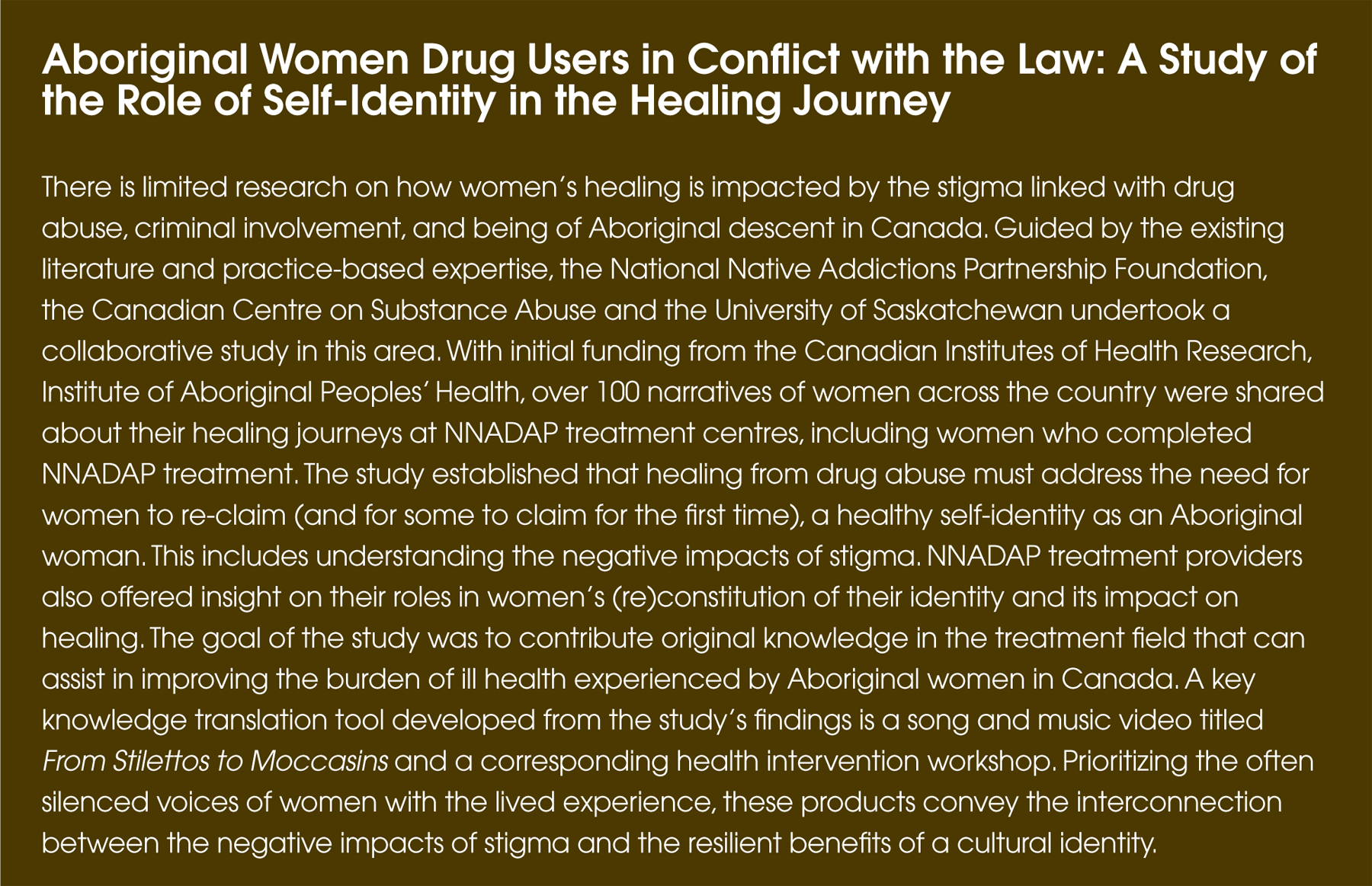
Pharmacological Approaches
>> Description
Medications can be central to treating addiction issues and support addictions recovery. When appropriately prescribed and administered, they can increase the chance that a client with addictions will, over time, reduce their substance use or achieve sobriety. Prescription medications are sometimes used in the treatment of addictions either as a substitute for the substance of abuse, or to help the person reduce or stop their abuse. Medications can also be central to treating mental health issues (see the Addressing Mental Health Needs section of this chapter for more information on the use of medications for mental health issues).
The correct use of pharmacotherapy can be a valuable part of treatment for those clients who need to include medication in their healing journey. Key components of pharmacotherapy include:
• Medical assessment;
• Follow-up and monitoring;
• Coordination of care; and
• Multi-disciplinary team approaches.
Service providers include individuals qualified to prescribe medication such as physicians, and in the case of some medications, nurse practitioners. Non-prescription medications may be recommended by various health care providers, including nurses and pharmacists, or specialized cultural practitioners. Community-based addictions workers can also have an important role for clients on medication by providing routine follow-ups and monitoring side effects.
>> Key Components
Medical Assessment
The vast majority of assessments are done by primary care providers in the communities such as general physicians and nurse practitioners. A medical assessment is required to determine a client’s need, suitability, and fit- ness for a particular medication. A client’s need relates to a review of the client’s symptoms and whether or not symptoms could be relieved or controlled by medication. Suitability relates to a person’s tolerance of the medication given their condition or diagnosis, and their fitness relates to whether they can safely take the medication without severe physical side-effects.
Follow-up and Monitoring
A person who is being prescribed medication needs to have ongoing follow-up with the appropriate health care provider. Symptoms and side-effects must be monitored and it is vital to determine the client’s tolerance level of medication to ensure proper dosage. This ongoing monitoring by a health professional may also be an opportunity to determine what additional services are necessary.
Coordination of Care
Some clients may need to be stabilized on a medication so that they can enter treatment (e.g., clients experiencing mental health issues). In these cases, community-based services may need to offer strong case management support to clients and link them with appropriate services, and assist them with making well-informed choices. Coordination of care includes physicians that provide pharmacological aspects of service working with the client and/or other health care providers.
Medication can be coordinated with the client’s broader treatment plan to ensure they complement other approaches to healing such as traditional and complementary medicine.

Multidisciplinary Team Approaches
A multidisciplinary team approach to care is often most effective when addressing all aspects of the client’s needs. This enables knowledge exchange between medical professionals and other service providers to ensure coordinated care plans, particularly for clients on medication. It facilitates long-term partnerships among physicians, advanced practice nurses, pharmacists, and communities in supporting addiction workers as part of a holistic approach. It links continuity of care, follow-up supports, supervision, and consultation for the person’s day-to-day
care providers. It can also ensure that prescribing physicians are aware if the client is using traditional medicines, so as to reduce possible drug interactions. A team approach also facilitates the inclusion of Elders and other cultural supports.
>> Current Status
There is much sensitivity around the use of prescription medications in First Nations communities. Some is rooted in the history of colonization, dominance of medical thinking, language and treatment, and a poor understanding by the medical system of the complex issues faced by First Nations people, families, and communities; and the cultural processes needed to sup- port and empower them. This reinforces the belief that pharmacotherapy services are not always culturally safe. There is also growing awareness of the preventative and curative treatment value of Indigenous and complementary medicines, (e.g., to ease stress, anxiety and depression, to help build coping skills, and build resilience). It is also recognized that not all approaches have to involve medication.
Pharmacotherapy, however, can be a useful addition to other forms of treatment, and certain prescription drugs can help people to resist urges during their first year of abstinence. Opiate replacement therapy, such as methadone and the buprenorphine/naloxone combination (Suboxone®), has been shown to be very helpful to clients, their families and their communities when there are clear management plans in place.
A client’s overall health can improve while on these medications because with symptoms or cravings controlled, clients may be more likely to access health services and live healthier lifestyles. Their risk for contracting diseases like Hepatitis C and HIV is lower and they are more likely to have better relationships with family and friends.
Both opiate replacement therapy, such as methadone and Suboxone®, and naltrexone (Revia®, lowers a per- son’s craving for alcohol), can be very useful in helping clients to complete an addiction treatment program. Completing a treatment program is one of the most important factors for long-term sobriety. Medications such as those listed above help clients dealing with withdrawal symptoms, support them to enter treatment at an early stage, and may increase the chance that they will complete treatment. For these reasons, it is recognized that medication is important for managing the physical aspect of addictions. Other aspects of treatment can address the emotional, spiritual and mental health needs to ensure a holistic approach.
Supports are limited for clients who are using medications and who also wish to access NNADAP treatment services.
• Treatment staff lacks specific training in how to deal with clients using medications as part of their addiction recovery.
• Treatment staff needs more support from physicians who have knowledge regarding addiction medications.

>> Renewal Opportunities
• Information on pharmacotherapy for service providers to provide more clarity about the scope of practice, screening, protocols, and when/ how to seek assistance from a health professional and specialized cultural practitioner. Training and knowledge translation activities at all levels will help to build awareness of pharmacological and traditional medicine approaches to treatment, as needed.
• Training for addictions workers, nurses, doctors, and CHRs in mental health disorders would increase knowledge of the most up-to-date treatments (both behavioural and pharmacological). This will then allow NNADAP workers to inform physicians of a mental health or addiction issue that might require a pharmacological approach.
• Training for doctors and others able to prescribe medication on the factors that influence substance use and mental health issues among First Nations people, including potential cultural differences in understanding and treating these issues, as well as specific considerations for providing pharmacological support. This may involve coordination with professional and/or licensing organizations, in addition to other partners in prevention, provincial, and local health authorities.
• Recognition of the role and usefulness of team- based approaches including Elders and cultural supports as part of a multidisciplinary team. This would allow knowledge exchanges between medical professionals and other service providers to ensure coordinated care plans, and also promote information sharing, dialogue, and teamwork to address the stigma and fears linked to the use of medication.
• Involving clients themselves to be a part of the team and promote sharing and dialogue among physicians, communities, families, and clients with the goal of creating a safe setting for addressing challenges.
• Treatment centres’ access to physicians, pharmacists and mental health professionals who are familiar with addictions so they can provide input into the development of policies and program- ming, as well offer support in the treatment of individual clients.
Accreditation
>> Description
Accreditation is a quality improvement process focusing on client safety and quality of work life, whereby addiction treatment centres are assessed against national standards of excellence. These standards measure clinical, operational, and governance-based performance. They provide a clear picture of strengths, areas for improvement, and levels of risk within an organization. The accreditation process is based on how well an organization complies with national standards and it measures the quality of services that clients receive.
In general, most accreditation processes consist of a three-year cycle that begins with an organizational self- assessment against standards of excellence. The next step usually involves a peer review that is done by external reviewers. They interview staff at all levels of the organization/health service, including governance, management, staff and organizational partners, as well as clients and their family members.
Key components of a strong accreditation approach are:
• Assessing organizational readiness;
• Choosing an accreditation body/organization;
• Conducting self-assessment and evidence gathering;
• Peer review;
• Report and recommendations; and
• Follow-up and continuous improvement.
>> Key Components
Assessing Organizational Readiness
The first step in an accreditation process is to gather information to find out how ready the organization is for accreditation. This generally involves the organization’s board of directors and staff having a discussion about the potential risks and benefits of accreditation. For accreditation to be successful, organizational consensus must exist at the very start of the process. Readiness also explores the organization’s capacity related to pol- icy, planning and measurement of specified indicators throughout the organization, defined processes for service delivery, and linkages with partners.
Choosing an Accreditation Body / Organization
It is important to research all the options available for accreditation since many bodies may provide accreditation in a given field. Organizations need to seek out an accreditation body that will be responsive to their needs, as well as Health Canada accreditation policies. Some important factors are costs, level of detail in the standards, reporting time lines and the process requirements.
Conducting Self-assessment and Evidence Gathering
Once an organization selects an accreditation body, it will need to take some time to understand the standards structure and how processes will be measured within this structure. During this phase of the process, time is needed to gather policies, practices, and evidence that support organizational ratings based on a set of standards.
Peer Review
A peer review is generally set up after the organizational self-assessment has been sent to the accreditation body. One to three reviewers will visit the organization to gather more evidence. During this part of the process, they may conduct interviews with staff, board, clients, and former clients.
Report and Recommendations
Quality in addictions programming is assessed by examining structure, process, and outcomes. Structure involves having the resources and infrastructure that are needed to conduct tasks, such as having the human, financial and program resources to provide care, as well as the facilities, governance, standards, and policies in place. Process involves the delivery of health services, namely how it is done, inputs-tasks-outputs and the care itself. Outcomes involve the results, such as client satisfaction, staff satisfaction, effective care, efficient use of resources and measurement of the extent to which services impact client health.
Using information from the organization’s self- assessment, combined with information gathered and verified during the peer review, the accreditation body provides a report on its findings. This report usually comes in the form of recommendations for continuous quality improvement. Depending on the accreditation body that is used, the time between peer review and the report can vary from a few days to many months.
Follow-up and Continuous Improvement
In this phase, an organization works to implement the recommendations and makes changes to policies, practices or environmental supports based on the recommendations of the report. The process may include a re-visit from the accreditation body or the submission of follow-up evidence of how the organization has worked to address certain recommendations.
>> Current Status
Accreditation is being provided for treatment centres within NNADAP/NYSAP and community based health services inclusive of NNADAP by one of three main accreditation bodies:
• Accreditation Canada (AC)
• Commission on Accreditation of Rehabilitation Facilities (CARF)
• Canadian Accreditation Council (CAC))
Health Canada has an accreditation framework document that outlines some key features of accreditation. This outline informs programs for which accreditation is mostly voluntary, and provides details on incentive sup- ports for programs that begin the accreditation process and meet the criteria.
The accreditation process is initiated by a First Nations treatment centre or community-based substance use-related service within a broader community health service and is managed by a non-government accrediting body. Centres may receive funding from Health Canada to engage in the accreditation process with an eligible accreditation body. Among First Nations addictions programming, awareness of accreditation and its benefits has grown as more organizations feel proud of their success and have met standards of excellence. What started as a grassroots movement has gained force and is now seen as the model for many NNADAP/NYSAP treatment centres. The success of accreditation to date is largely due to the desire of First Nations services to provide a high level of quality health services to their clients.
Some of the challenges linked to accreditation relate to the higher costs and workload for centres and their staff during the accreditation process. Some centres question whether accreditation programs which are mostly focussed on health care services are relevant. For example, a focus on client safety within the context of a community health and residential addiction treatment centre is very different from in acute health care settings. If accreditation is going to be seen as useful, the standards must be relevant for community services. In addition, there are concerns about the fact that program funding for accreditation does not cover the entire cost of compliance with accreditation recommendations.
Although accreditation addresses all structures, it does not replace evaluation of specific programs. For example, accreditation does not prescribe the best approach to offering any health care service or to addiction treatment (namely the evaluation of a specific theory or of a cultural approach to health service delivery). It does, however, ask how the organization uses its knowledge of best practices to guide its service delivery and how the organization monitors and measures effectiveness.
>> Renewal Opportunities
• Support for treatment centres to bear the costs of compliance with accreditation standards. This sup- port must be fair, scalable, adaptable, and sustain- able. It must include both the implementation of accreditation and compliance with recommendations stemming from this process.
• Accreditation standards that have meaning to First Nations culture can provide a holistic framework within the accreditation process, and cultural relevance needs to be integrated into assessments.
• Having standards that can accommodate First Nations holistic health and healing practice requires ongoing improvements to the accreditation processes and standards. This will help to ensure that these standards are more tuned into the operations and realities of First Nations addictions facilities and programs.
• Ongoing evolution of the accreditation process will ensure that the process meets the best standards possible in an ever-changing sector. The standards must be a benchmark of excellence.
• Support for knowledge exchange among centres specific to accreditation will help to ensure that practice- driven success can be shared broadly. This may include a national program resource centre or a centre of excellence that promotes accreditation champions. The goal would be to further support accreditation within First Nations communities and organizations.

